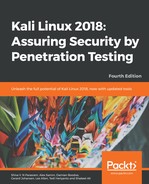The technical assessment report plays a very important role in addressing the security issues raised during the penetration testing engagement. This type of report is generally developed for techies who want to understand the core security features handled by the target system. The report will detail any vulnerabilities, how they can be exploited, what business impact they could bring, and how resistant solutions can be developed to thwart any known threats. It has to communicate with all-in-one secure guidelines for protecting the network infrastructure. So far, we have already discussed the basic elements of the executive and management reports. In the technical report, we extend these elements and include some special themes that may draw substantial interest from the technical team at the target organization. Sometimes, sections such as project objectives, vulnerability risk classification, risk matrix, statistics, testing methodology, and assumptions and limitations, are also a part of the technical report. The technical report consists of the following sections:
- Security issues: The security issues raised during the penetration testing process should be clearly cited in detail, such that for each applied attack method, you must mention the list of affected resources, its implications, original request and response data, simulated attack request and response data, provide reference to external sources for the remediation team, and give professional recommendations to fix the discovered vulnerabilities in the target IT environment.
- Vulnerabilities map: This provides a list of discovered vulnerabilities found in the target infrastructure, each of which should be easily matched to the resource identifier (for example, the IP address and target name).
- Exploits map: This provides a list of the successfully checked and verified exploits that worked against the target. It is also crucial to mention whether the exploit was private or public. It may be beneficial to detail the source of the exploit code and for how long it has been available.
- Best practices: This emphasizes any better design, implementation, and operational security procedures the target may lack. For instance, in a large enterprise environment, deploying edge-level security could be advantageous for reducing the number of threats before they make their way into a corporate network. Such solutions are very handy and do not require technical engagement with production systems or legacy code.
Generally speaking, the technical report brings forward the ground realities to the relevant members of the organization concerned. This report plays a significant role in the risk management process and will likely be used to create actionable remediation tasks.
